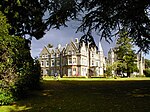The Jurors

The Jurors is an artwork by Hew Locke, installed at Runnymede in Surrey in 2015 to commemorate the 800th anniversary of the sealing of Magna Carta. Commissioned in 2014 by Surrey County Council and the National Trust, it comprises 12 high-backed bronze chairs placed in a grassy meadow, arranged in a rectangular formation to face inwards as if around a table, with one chair at each end and five along each side. Each chair measures 123 cm × 61 cm × 57 cm (48 in × 24 in × 22 in), and the installation covers an area of 4 m × 19 m (13 ft × 62 ft). The surfaces of each chair are decorated with images and symbols representing freedom, the rule of law, and human rights, clockwise from one end: The decorations cast into the chairs also include garlands of flowers, as a reference to the Victorian language of flowers, including coltsfoot, black-eyed Susan and horse chestnut for aspects of justice, and hops for injustice; images of ermine as a reference to the traditional robes of English judges; and keys to prison cells, including a key to the Bastille which was given to George Washington by the Marquis de Lafayette in 1790. Locke deliberately avoided representing a "collection of heroes", and intended his 24 selected scenes to provoke reflection and debate. Locke considers that the artwork is only completed when each chair is occupied by people discussing the issues depicted. It was dedicated on 15 June 2015, at a ceremony attended by Prince William, Duke of Cambridge. The ceremony included a dramatised performance of the poem "Or In Any Other Way" by Owen Sheers, in which twelve actors emerged from the crowds to recite a stanza each, and then took a place on one of the chairs.
Excerpt from the Wikipedia article The Jurors (License: CC BY-SA 3.0, Authors, Images).The Jurors
Windsor Road,
Geographical coordinates (GPS) Address Website Nearby Places Show on map
Geographical coordinates (GPS)
| Latitude | Longitude |
|---|---|
| N 51.44665 ° | E -0.56652 ° |
Address
The Jurors
Windsor Road
TW20 0AE
England, United Kingdom
Open on Google Maps







